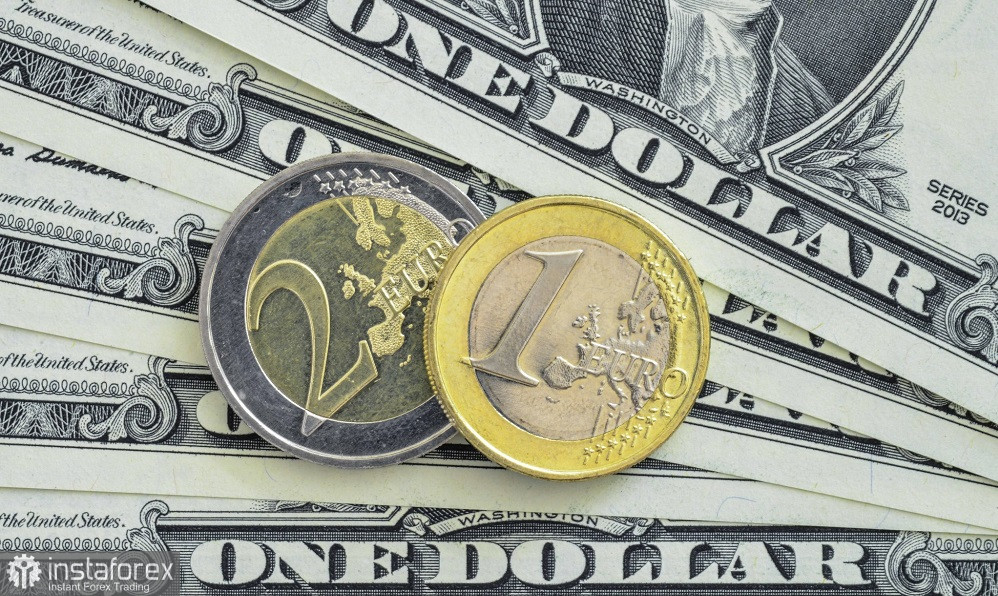The euro/dollar pair is slowly sliding after yesterday's failure to test the resistance level of 1.0870 (the upper line of the Bollinger Bands indicator on the daily chart). The price reached 1.0867, after which it reversed and headed towards the bottom of the 8th figure.
If we look at the weekly chart, we can see that the pair demonstrates upward dynamics. However, this is exactly the case when a weekly time frame should not be trusted. The fact is that buyers of the euro/dollar pair cannot overcome the intermediate price barrier of 1.0870 and the main resistance level of 1.0900 (the lower boundary of the Kumo cloud on D1). At least, it is not a good idea to buy at the moment, even though the pair is formally within the uptrend. Bulls have been trying to approach the 9th figure for the second week in a row. However, each time they return to their previous positions when approaching the 1.0900 mark, traders take profits, thus extinguishing the upward impulse.

The contradictory fundamental background contributes to such uncertainty. The market sentiment is changing very fast. That is why the pair cannot decide where to move. The price is hovering within the limits of the 8th figure, waiting for important information, which will push it either down, under the level of 1.0780, or up, above the target of 1.0900. Let me remind you that a similar situation was observed in the first half of February. During two weeks, the pair was trading within the 7th figure, testing the 6th and 8th figures. As a result, the uptrend prevailed, allowing the pair to change the range. As a result, it got stuck within the 100-point range.
Yesterday was an indicative day. The pair grew on the background of weak reports that were published in the US. However, at the end of the day, the currency managed to recoup its losses and rise even higher amid risk aversion.
Thus, according to the data, US durable goods orders in January decreased by 6.1%, against the forecast of a 4.9% decline. The indicator showed the deepest drop since May 2020, when the US was suffering the aftermath of the coronavirus pandemic. Core orders for durable goods, i.e., excluding transportation, also declined by 0.3% (the lowest value since November 2023), while most experts predicted an increase of 0.2%. Excluding the defense industry, orders fell by 7.3% (the weakest result since June 2020).
The consumer confidence index published yesterday, calculated by the Conference Board group, also disappointed dollar bulls. The indicator showed a strong upward trend for three months, namely from November to December, rising to 110.9 points (the highest level since July 2023). January was supposed to be the fourth month in this series, as most experts expected to see the indicator at 114.8 (the highest level since December 2021). Instead, the indicator came out in February at 106.7 points, collapsing to a three-month low. The report shows a significant decline in the current situation index (to 147.2 points from the previous value of 154.9 points) and the expectations index (to 79.8 points from the previous value of 81.5 points). In addition, 12-month inflation expectations fell significantly to 5.2%.
What is more, the report on the real estate market in the US was also disappointing. The S&P/Case Shiller home price index decreased by -0.3% in December, continuing the downward trend (in November, the index decreased by 0.2%).
Against this backdrop, the US dollar index fell to 103.53, and the euro/dollar pair updated the daily high at 1.0867. However, at the end of the US trading session, buyers ran out of steam, and sellers seized the initiative. As a result, the pair closed the day on a minor note.
This could be explained by risk aversion and the growth in Treasury yields. The US stock market ended Tuesday with mixed trading. In particular, the Dow Jones index declined by 0.25%. The yield of 10-year government bonds crossed the 4.3% mark.
ECB President Christine Lagarde, who delivered her annual report to the European Parliament at the beginning of the week, also did not support the euro. She said that eurozone inflation would continue to fall, but the regulator needed to see more signs of the indicator moving towards the target level to decide whether to ease the monetary policy. She also added that wages would become an increasingly important driver of price dynamics in the coming quarters. Notably, wage growth in the eurozone slackened to 4.5% in the fourth quarter. Figures for the first quarter of 2024 will be released in May. This release appears to play a key role in the EBC's key rate decision.
Thus, during one day, both buyers and sellers found arguments to strengthen their positions.
However, the pair is still trading within the 8th figure, reflecting the general indecision of both bulls and bears. It seems that traders are waiting for the key releases this week. On Thursday, the US core PCE index will be published, and on Friday, the eurozone will issue a report on inflation growth. Therefore, it is not worth trusting these intraday price fluctuations, at least until bears touch the support level of 1.0780 (the middle line of the Bollinger Bands indicator on the daily chart) or until bulls exceed the target of 1.0900 (the lower boundary of the Kumo cloud in the same time frame). In all other cases, it is better to take a wait-and-see approach.
 English
English 
 Русский
Русский Bahasa Indonesia
Bahasa Indonesia Bahasa Malay
Bahasa Malay ไทย
ไทย Español
Español Deutsch
Deutsch Български
Български Français
Français Tiếng Việt
Tiếng Việt 中文
中文 বাংলা
বাংলা हिन्दी
हिन्दी Čeština
Čeština Українська
Українська Română
Română

